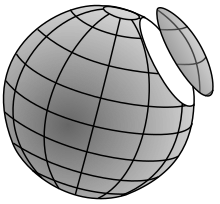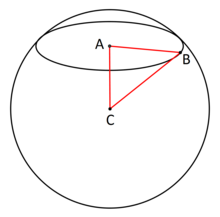Spherical circle
This article includes alist of references,related reading,orexternal links,but its sources remain unclear because it lacksinline citations.(May 2024) |

Inspherical geometry,aspherical circle(often shortened tocircle) is thelocusofpointson asphereat constantspherical distance(thespherical radius) from a given point on the sphere (thepoleorspherical center). It is acurveof constantgeodesic curvaturerelative to the sphere, analogous to aline or circlein theEuclidean plane;the curves analogous tostraight linesare calledgreat circles,and the curves analogous to planarcirclesare calledsmall circlesorlesser circles.If the sphere is embedded in three-dimensionalEuclidean space,its circles are theintersectionsof the sphere withplanes,and the great circles are intersections with planes passing through thecenterof the sphere.
Fundamental concepts
[edit]Intrinsic characterization
[edit]A spherical circle with zero geodesic curvature is called agreat circle,and is ageodesicanalogous to a straight line in the plane. A great circle separates the sphere into two equalhemispheres,each with the great circle as its boundary. If a great circle passes through a point on the sphere, it also passes through theantipodal point(the unique furthest other point on the sphere). For any pair of distinct non-antipodal points, a unique great circle passes through both. Any two points on a great circle separate it into twoarcsanalogous toline segmentsin the plane; the shorter is called theminor arcand is the shortest path between the points, and the longer is called themajor arc.
A circle with non-zero geodesic curvature is called asmall circle,and is analogous to a circle in the plane. A small circle separates the sphere into twospherical disksorspherical caps,each with the circle as its boundary. For any triple of distinct non-antipodal points a unique small circle passes through all three. Any two points on the small circle separate it into twoarcs,analogous tocircular arcsin the plane.
Every circle has two antipodal poles (or centers) intrinsic to the sphere. A great circle is equidistant to its poles, while a small circle is closer to one pole than the other.Concentriccircles are sometimes calledparallels,because they each have constant distance to each-other, and in particular to their concentric great circle, and are in that sense analogous toparallel linesin the plane.
Extrinsic characterization
[edit]
If the sphere isisometricallyembeddedinEuclidean space,the sphere'sintersectionwith aplaneis a circle, which can be interpreted extrinsically to the sphere as a Euclidean circle: a locus of points in the plane at a constantEuclidean distance(theextrinsic radius) from a point in the plane (theextrinsic center). A great circle lies on a plane passing through the center of the sphere, so its extrinsic radius is equal to the radius of the sphere itself, and its extrinsic center is the sphere's center. A small circle lies on a planenotpassing through the sphere's center, so its extrinsic radius is smaller than that of the sphere and its extrinsic center is an arbitrary point in the interior of the sphere. Parallel planes cut the sphere into parallel (concentric) small circles; the pair of parallel planes tangent to the sphere are tangent at the poles of these circles, and thediameterthrough these poles, passing through the sphere's center and perpendicular to the parallel planes, is called theaxisof the parallel circles.
The sphere's intersection with a second sphere is also a circle, and the sphere's intersection with a concentricright circular cylinderorright circular coneis a pair of antipodal circles.
Applications
[edit]Geodesy
[edit]In thegeographic coordinate systemon a globe, theparallelsoflatitudeare small circles, with theEquatorthe only great circle. By contrast, allmeridiansoflongitude,paired with their opposite meridian in the otherhemisphere,form great circles.
References
[edit]- Allardice, Robert Edgar(1883),"Spherical Geometry",Proceedings of the Edinburgh Mathematical Society,2:8–16,doi:10.1017/S0013091500037020
- Casey, John(1889),A treatise on spherical trigonometry,Hodges, Figgis, & co.,ISBN978-1-4181-8047-8
- Papadopoulos, Athanase(2014), "On the works of Euler and his followers on spherical geometry",Gaṇita Bhārati,36:53–108,arXiv:1409.4736
- Todhunter, Isaac;Leathem, John Gaston (1901),Spherical Trigonometry(Revised ed.), MacMillan

